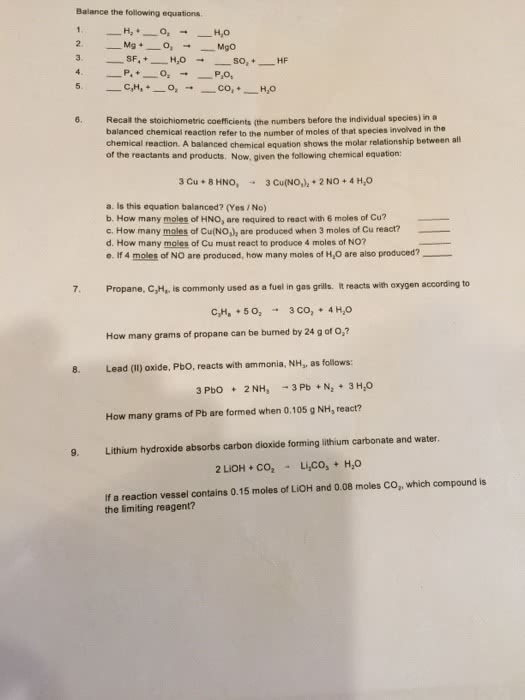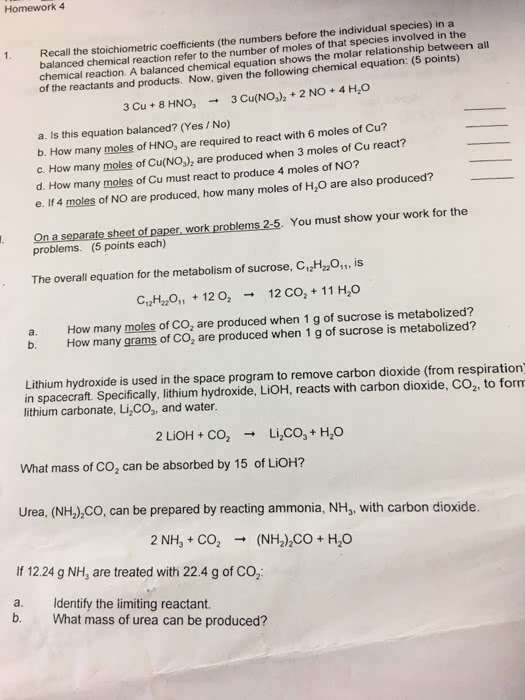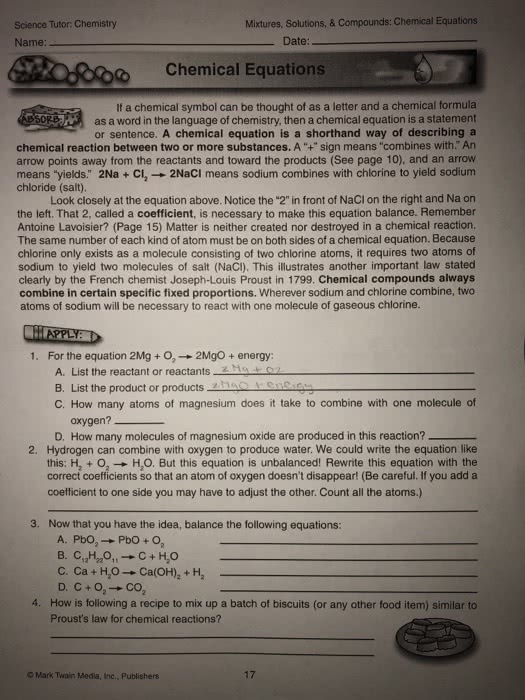CHEM 1311 Lecture Notes - Lecture 7: Sodium Hydroxide, Reagent, Ammonia

Chapter 8: Chemical Reactions
Focus of this section: Chemical Equations
Using balanced equations to
solve problems
Chemical equations: represent chemical “sentences”
-- Read as a sentence:
2 CH3OH(l) + 3 O2(g) → 2 CO2(g) + 4 H2O(l)
“Two methanol molecules react with three oxygen
molecules to produce (yield, form) 2 two carbon
dioxide molecules and four water molecules”
-- Reactant: any species to the left of the arrow
(consumed)
-- Product: any species to the right of the arrow (formed)
-- State symbols: (s) solid (l) liquid
(aq) water solution (g) gas
Balancing Chemical Equations:
• Balanced: same number and kind of atoms on each side of
the equation (conservation of mass)
• (stoichiometric) coefficients: numbers before formulas
2 CH3OH (l) + 3 O2 (g) → 2 CO2 (g) + 4 H2O (g)
2 C 2 C
8 H → 8 H
8 O 8 O

• balance by adding appropriate stoichiometric coefficients
• requires a largely trial-and-error approach
• few guidelines:
DO’s:
1. Change coefficients for compounds before
changing coefficients for elements (never
change subscripts!)
2. Balance elements other than H and O first
3. Treat polyatomic ions as units rather than
individual elements (if appear on both sides)
4. Use smallest whole-number coefficients
DON’Ts:
1. do not change subscripts in chemical formulas
2. don’t add or subtract reactants or products
- - - - - - - - - - - - - - - - - - - - - - - - - - - - - - - - - - - - - - - - - - - -
Balance:
NaOH + H3PO4 → Na3PO4 + H2O
P4O10 + H2O → H3PO4
SO2 + O2 → SO3
(NH4)3PO4 + NaOH → Na3PO4 + NH3 + H2O
C6H14 + O2 → CO2 + H2O
- - - - - - - - - - - - - - - - - - - - - - - - - - - - - - - - - - - - - - - - - - - -

Indirect Analysis: useful for determining Empirical Formulas
• seldom isolate individual elements
-- often trap elements in compounds
• Combustion Analysis:
-- analysis of organic compounds (C,H and sometimes O,
N and S) carried out using an apparatus like the
one below
2 CH3OH + 3 O2 → 2 CO2 + 4 H2O
= complete combustion of methanol (excess O2):
• all carbon ends up in CO2
moles C moles CO2
• all hydrogen ends up in H2O
moles H 2x moles H2O
• oxygen:
(mass of O) = (total mass CH3OH) –
(mass C + mass H)
convert mass O to mol O
Document Summary
2 ch3oh(l) + 3 o2(g) 2 co2(g) + 4 h2o(l) Two methanol molecules react with three oxygen molecules to produce (yield, form) 2 two carbon dioxide molecules and four water molecules . - reactant: any species to the left of the arrow (consumed) - product: any species to the right of the arrow (formed) - state symbols: (s) solid (aq) water solution (l) liquid (g) gas. Balancing chemical equations: balanced: same number and kind of atoms on each side of the equation (conservation of mass, (stoichiometric) coefficients: numbers before formulas. 2 ch3oh (l) + 3 o2 (g) 2 co2 (g) + 4 h2o (g) 8 o: balance by adding appropriate stoichiometric coefficients, requires a largely trial-and-error approach, few guidelines: So2 + o2 so3 (nh4)3po4 + naoh na3po4 + nh3 + h2o. Indirect analysis: useful for determining empirical formulas: seldom isolate individual elements. - often trap elements in compounds: combustion analysis: - analysis of organic compounds (c,h and sometimes o,




